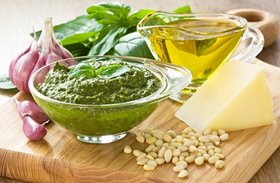
On a recent trip to Northern Italy, a pottery merchant and I passed the time of day as he painstakingly wrapped an exquisite rooster pitcher in layer upon layer of newspaper to safeguard it on my trip home. When I told him I was a food writer, we got to talking about the region’s cuisine.
“You know,” he said, “it’s interesting: our cuisine and southern France’s use essentially the same ingredients. But where we Italians use a maximum of four or five ingredients in a dish, their recipes begin with at least nine or ten.”
I thought about this the other day, as I harvested a crop of basil to lay down some pesto for the winter. Simplicity is the secret to Liguria’s famous sauce, pesto Genovese, which perfectly fuses the culinary bounty of the sun-kissed Cinque Terre coastline: extra virgin olive oil, green basil, pine nuts, wild garlic, and tangy sea salt make the base. Sounds simple, but when they come together with a salty aged cheese such as Parmesan or pecorino, the result is magical.
“Green gold” as I like to think of it, has been a part of Italian cuisine since ancient times. Virgil has a delightful description of a peasant farmer breakfasting on a garlic and walnut paste in his poem, “Moretum.” In the 15th and 16th century, Genovese sailors used garlic and walnut paste preserved in salt and olive oil to stave off sickness during the long voyages of discovery, and one can imagine that the scent of fresh wild basil at home required only a short leap of imagination.
Making pesto in ancient times was a labor of love, as the ingredients had to be pounded together into a paste using a mortar and pestle, indeed the word “pesto: comes from the verb, “pestare,” which means to pound.
Classic pesto Genovese is made from basil and pine nuts, but there are endless riffs on the original: rucola and walnut, parsley and pistachio, purple basil and walnut, and even kale and almond. The method is the same and the good news is that pesto without cheese freezes exceptional well, so while there is a glut of basil and garlic in your garden get out the food processor and lay some down for the winter!
Ingredients
4 cups of fresh basil leaves, removed from their stems, washed and patted dry
5 cloves of garlic, finely minced
3/4-cup of pine nuts, gently toasted in a frying pan over medium heat until they begin to steam
1-1/2 cups of best quality, extra virgin olive oil
1 Tbl of best quality sea salt
If serving immediately: 2/3 cup of grated fresh parmesan or pecorino cheese, with extra for topping
Instructions
1. Combine the garlic, pine nuts, basil and salt in a food processor, fitted with a steel blade.
2. Pulse to combine the ingredients 5-6 times before running the motor steadily as you pour the olive oil in a steady stream to combine.
3. Scrape the sides of the food processor with a rubber spatula and continue to combine until smooth, adding more olive oil if the mixture is too dry.
4. To store, decant the pesto into a clean glass jar and cover with 1/8-inch of olive oil to seal. Be aware that the strength of the salt will diminish during the freezing process so do adjust the final seasoning for the desired taste.
5. If you are serving immediately, fold the grated cheese into the pesto and toss with al dente pasta or drizzle over heirloom tomatoes!
Alexander+Roberts offer trips to Italy and Cinque Terre to suit every palate, including
A Little Tour of Cinque Terre which is a flexible way to get to know this delicious region on the Ligurian coast.